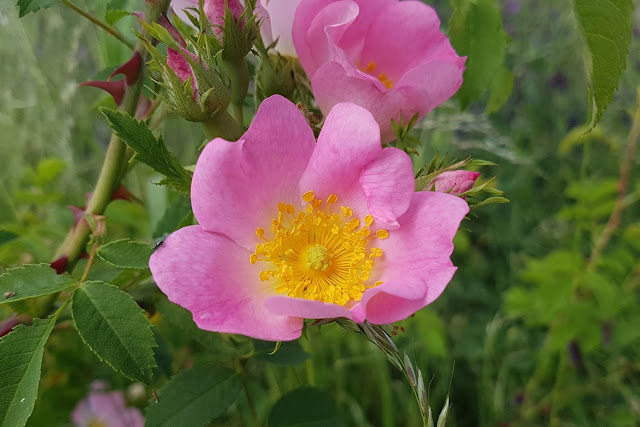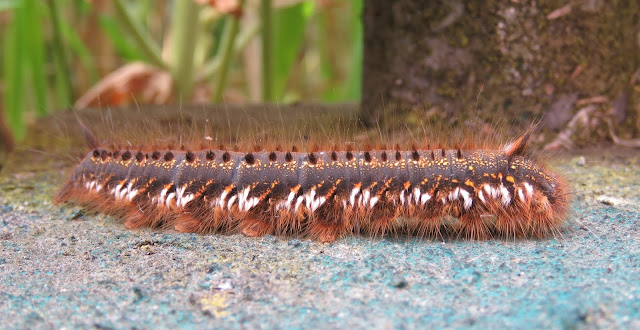The Kids Birdwatching Club at RSPB Rainham Marshes has been around for at
least twelve years now, thanks to the initial support of Peter Holden who
encouraged me in my plan to set up an event for budding young ornithologists on
the reserve at a time when an onsite Wildlife Explorers Club was not a
possibility.
It has always catered for all ages and by involving the
parents it has always been an eclectic group of likeminded souls with a love
for being outside and learning about the natural world around them with a
common passion running between them.
Some of those ‘kids’ are now at Uni studying the natural
sciences and volunteering on far flung Scottish islands, while one is a semi pro cyclist with a bright sporting future – but
still goes birding. Once bitten...
And so after that little nostalgic preamble I will take you
on the KBC walk that we undertook on a grey but sultry Saturday. We headed out along the river wall with the
sound of alarming Redshanks and Lapwings out across the meadows as they gave
chase en masse to one the male Marsh Harriers.
It is a wonder that they can hunt at the Centre end at all! The local
breeding Little Egrets were scattered all across the marsh collecting food for
every growing young a few miles away.
 |
| Marsh Harrier - Bernard Bradshaw |
 |
| LIttle Egret - Joan Chatterely |
 |
| Redshank - Lawrence Rogers |
Common Terns fished along the line of the Tudor seawall that
was just visible with its floating seaweed and you could hear the splash as
they hit the water. Shelduck and
Cormorants passed by and Starlings were foraging on the saltmash.
 |
| Common Tern |
The banks were awash with swathes of purple Tufted Vetch
interspersed with the yellows of Goatsbeard and Hawksbeard and the single spike
of Common Broomrape that I found last week had now multiplied to 11 spikes with
it host plant – Perforate St John’s Wort within a foot.
 |
| Common Broomrape |
 |
| Common Broomrape |
 |
| Perforate St John’s Wort |
Black-tailed Skimmers quartered the path at about six inches
and many Blue-tailed Damselflies were quite literally hanging around while the
kids were fascinated with the tale of how a Robin’s Pin Cushion is created by
the Dog Rose reacting to the alien presence of the tiny Bedagaur’s Gall Wasp
larvae living inside it!
 |
| Dog Rose |
 |
| Robin’s Pin Cushion |
Down through the seawall gate passing singing Whitethroats
on the way to be greeted by a Cuckoo on the top of number one of the Shooting
Butts and a cloud of Swifts careening around with their mouths open trying to
hoover up flies.
 |
| Cuckoo |
The Stinging Nettles were covered in spiny Peacock Butterfly
caterpillars, Seven Spot Ladybirds and their larvae, shiny powder green Weevils
and egg carrying Wolf Spiders.
 |
| Peacock Butterfly
caterpillar |
 |
| Phyllobius pomaceus |
 |
| Wolf Spider |
The Bearded Tits pinged around on the Dragonfly Pool and a
Painted Lady was seen along with the first Large Skipper and Meadow Brown and a
goodly number of Common Blues.
 |
| Painted Lady - Steve Drake |
The Marsh Harriers put on a great show from the Butts Hide
and a new Shoveler brood was found on the Targets as well as seven Teal and two
Avocets. A Buzzard circled further back and several Kestrels hovered across the
marsh.
 |
| Marsh Harrier |
As we reached the Northern Boardwalk we started to notice
Drinker moth caterpillars – they were everywhere and you had to be careful
where you walked as they had a penchant for just sitting in the middle of the
path which is quite dopey really given the relish with which Cuckoos consume
them!
There were some good spiders to be seen including a smart little one called Agalenatea redii and a rather splendid Nuctenia umbratica that was guarding her egg sack on a hand rail.
 |
Agalenatea redii - Robyn actually found this one a cople of weeks ago
|
 |
| Nuctenia umbratica |
Another male Bearded Tit bounced across and the resident
Cetti’s Warblers and Reed Buntings were once again in full song as they
reaffirmed their territories to help secure a second brood. The latter were
especially obliging.
Aveley Pool was covered in independent Pochard ducklings and
the first two Tufted Duck broods were also out but with attentive mothers still
in attendance while the Great Crested Grebes and Mute Swans still had their
respective families in tow.
 |
| Pochard family |
 |
| Great Crested Grebe family |
The Marsh Frogs were now quite vocal but we could not find a
Grass Snake or Water Vole this time. Down towards the woodland there were some
good insects on the Brambles with several hoverfly species including the first Volucella bombylans of the season,
fluffy Eristalis intricaria and a
couple of spotty eyed Eristalinus
sepulchralis. Chiffchaffs and
Blackcaps were singing well and I had to move a young Song Thrush from the path
and pop him in a tree out of harms way.
 |
| Eristalinus
sepulchralis |
 |
| Mystery larvae on Great Willowherb and... |
 |
| and... equally mysterious grubs leaf mining Curled Dock leaves... any help accepted! |
A post-lunch look at the Bee Orchid in the picnic area and
then it was time to prepare for the Late Night Opening which was quiet from a
visitor point of view but relaxed from ours and those that came along had a
great evening out on the marsh where even the Barn owl came out.
 |
| Bee Orchid |
A circuit late on to lock up was peaceful despite the
continuous croakings of the Marsh Frogs but was interspersed by the calls of
Lapwing and Redshank and the kipping song of at least two inflated Water
Rails...

































No comments:
Post a Comment